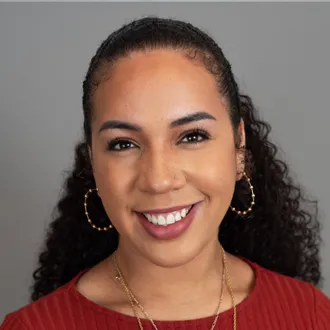Language, Culture, and Trust: Addressing Gaps in Palliative Care for Hispanic Patients

As part of CAPC’s Project Equity, an initiative to catalyze meaningful progress toward health equity for all people living with serious illness, CAPC recently released The Health Care Experience of Hispanic Patients with Serious Illness: A Literature Review. While the literature review describes what Hispanic patients experience, we've been working behind the scenes to figure out how we can improve access to palliative care for this population.
With Hispanic people representing the largest ethnic community within the broader U.S. population, which is projected to make up nearly one in four individuals by 2035, it is critical to address the unique challenges they face when living with a serious illness. Note: We acknowledge the diverse ethnicities within this population; in this blog, the term “Hispanic” will be used to encompass both people of Latin American heritage and those who are Spanish speaking.
Through interviews with four community leaders who care for and represent this community, we sought to gain a deeper understanding of the challenges and barriers to high-quality care. They bring a breadth of expertise across the health care continuum, from direct care delivery to community outreach, engagement, and research, spanning adult and pediatric populations and rural and urban geographies. As Hispanic health professionals, the interviewees, listed below, also recounted their own experiences as patients and as caregivers.
- Daniel Rivera, Latino Community Liaison at Providence Home and Community Care
- Sasha Perez, MPH, Senior Program Manager, DEI Research & Professional Development, Brookdale Department of Geriatrics and Palliative Medicine, Icahn School of Medicine at Mount Sinai
- Laura Ramirez, MPH, Director of Nutrition Services, Yakima Valley Farm Workers Clinic
- Alexa Manrriquez, MD, Pediatric Palliative Care Clinician, Seattle Children’s Hospital
Interviewees identified and provided additional context to the major barriers to palliative care in communication, cultural/personal values, and care accessibility. This blog provides actionable recommendations for health care organizations, palliative care teams, and clinicians working to ensure equitable access to high-quality care across these areas.
Language Barriers Can Hinder Access to Optimal Care Experiences
Interviewees identified communication as a significant barrier to high-quality care. They shared numerous instances in which they or their family members struggled to find health education resources or clinicians who could communicate in their preferred language. In a Pew Research study, 44% of Hispanic patients surveyed indicated that communication problems stemming from language and cultural differences significantly contribute to adverse health outcomes.
Interviewees recalled distressing experiences, such as being asked to translate complex medical information for seriously ill family members. For example, one interviewee recounted: “When I was 9, I had to translate for my grandma in the hospital…I had no idea what was going on, and it was terrifying.”
Even when translation services are available to patients with Limited English Proficiency (LEP), they are often provided via phone or tablet, which can limit the clinician’s ability to communicate with nuance, empathy, and clarity—qualities that are especially critical in conversations about serious illness.
"[Translation services] are often provided via phone or tablet, which can limit the clinician’s ability to communicate with nuance, empathy, and clarity—qualities that are especially critical in conversations about serious illness."
Cultural and Personal Values May Impact Care Quality
Interviewees stressed the importance of recognizing and respecting Hispanic patients’ religious practices and faith, particularly once diagnosed with a serious illness or at the end of life. One interviewee shared: “Many Latino patients don’t understand what palliative care is… For those who have heard of it, they think it means giving up or hastening death.” This common misperception that palliative care means "giving up" (or that it is a physical location where patients are transferred at the end of life) makes palliative care sound at odds with many patients' cultural preferences or values. To address this misconception, one participant emphasized the importance of explaining what palliative care is as a specialty and not a physical place.
"Family plays a central role for many Hispanic people, influencing decision-making processes and how care is provided and received."
Family plays a central role for many Hispanic people, influencing decision-making processes and how care is provided and received. One interviewee said they frequently see adult daughters shouldering the majority of caregiving for their older family members or siblings who are seriously ill. Another interviewee shared that caregivers often face a complex range of emotions and feelings, including joy and pride in taking on caregiving duties, but also intense burnout and exhaustion.
Given the strong cultural value placed on family, it is essential to routinely assess Hispanic caregivers’ needs and provide appropriate education and support throughout the course of a serious illness—to both the patients and their caregivers.
Affordable Culturally Responsive Palliative Care May Be Less Accessible to Hispanic Patients
Hispanic patients living with serious illness often face considerable barriers to accessing affordable, culturally responsive, high-quality care. A recent KFF study found that Hispanic adults are also more likely than White adults to say a neighborhood clinic or health center is their usual source of care (33% vs. 16%). Interviewees shared examples of patients traveling long distances to reach Federally Qualified Health Centers (FQHCs) or community-based clinics they trust. These facilities are more likely to have Spanish-speaking staff, and to offer culturally aligned services and flexible or discounted payment options for patients lacking insurance. While these clinics are essential sources of primary care, they often lack specialty services like palliative care, resulting in critical gaps for patients living with serious illness.
- As interviewee Daniel Rivera explained, many Hispanic patients in the Seattle area experience long wait times for general care at trusted community clinics. At the same time, he observed lower enrollment rates in specialty palliative care programs from this population, largely due to limited trust and weak ties between palliative care services and community providers such as FQHCs.
- Laura Ramirez also observed the absence of palliative care services at the Yamika Valley Farm workers’ clinic, for which this location also serves as a trusted, culturally- attuned source of care.
- Alexa Manrriquez, MD advocated for the continued expansion of palliative care beyond hospital walls and shared, “Community-based palliative care is vital… It’s difficult for many families to take off work or travel far, and many patients are homebound”.
Financial strain is also a common challenge to accessing health care, often driven by lack of health insurance. One interviewee shared that they received an unexpected $49,000 bill for a serious medical event while uninsured. This experience reflects a broader issue: as of 2023, Hispanic individuals have the highest uninsured rate of any racial or ethnic group in the United States, with nearly 24 percent lacking coverage. This gap in insurance access leaves many Hispanic patients vulnerable to overwhelming medical debt when serious illness strikes.
"Financial strain is also a common challenge to accessing health care, often driven by lack of health insurance."
Palliative care is often covered through Medicare, Medicaid, and most private insurance plans, especially when provided in hospitals or through hospice programs. Yet without access to insurance or clear information about these benefits, many Hispanic patients and families may miss out on the supportive services that palliative care can provide during serious illness.
How to Make Meaningful Improvements When Caring for Hispanic Patients
Below are three recommendations for how health care organizations, palliative care teams, and clinicians can effectively improve equity, trust, and cultural responsiveness.
1. Enhance Linguistic and Cultural Competence
- When possible, use an in-person qualified medical interpreter. Per NCP guidelines, in-person interpretation is recommended, instead of phone or video, as it preserves both accuracy and empathy. If in-person medical interpreters aren’t available within your organization, we encourage you to advocate for adding this service.
- Palliative care clinicians should build relationships with interpreters or even integrate them into palliative care teams, to work together to account for the diversity of dialects and accents among Spanish-speaking patients and families.
- If you are a hiring manager, advertise open roles where clinicians who represent the patient population you are serving may be seeking jobs (e.g. National Association of Hispanic Nurses [NAHN]).
2. Build Trust and Utilize a Culturally Sensitive Approach
- Connect with your supervisor to learn more about what cultural competence training opportunities are available at your institution. Often, these opportunities are housed under organizational professional development/enrichment offices (e.g., Mount Sinai’s Education and Training).
- Consider hiring Community Health Care Workers (CHWs) or Promotores de Salud, lay navigators who can provide linguistically and culturally congruent support. These team members are able to help with building trust via transparent communication and proactive education to dispel common misconceptions about palliative care through community outreach.
| Letter | Meaning | Action |
|---|---|---|
| L | Listen actively with empathy and respect |
- Identify yourself and greet the patient - Determine if there is a need for interpreter services - Set the tone by asking open-ended questions and being patient |
| E | Elicit the health beliefs of the patient as they relate to the reason for the visit as well as the patient’s health behaviors. |
- “What worries you the most?” - “Have you started any treatment on your own or gotten advice from others?" - “What do you think has caused the problem and what do you think started it?” - “How can I be of most help to you?” |
| A | Assess priorities, values, and supports in the patient’s life that may impact health and health behaviors. |
- “I’d like to get to know you more today. Could you tell me about yourself?” - "With whom do you live? Where do you work?” - “What brought you to this country? How does medical care differ here?” - “Do you have family and friends that help you with decisions or give you advice? - “Do you have any trouble reading medicine bottle or appointment cards?” - “Is transportation a problem for you?” |
| R | Recommend a plan of action with adequate explanation and understanding |
- Use language the patient can easily understand (avoid jargon). - Be guided by the patient about how much information to provide. - Check to make sure information has been understood by asking them to paraphrase. For example: “To be sure that we understand each other, would you please tell me what I just explained to you?” |
| N | Negotiate by involving the patient in next steps and decisions |
- “Now that we understand each other, let’s come up with a plan that works for you.” - “What do you think next steps should be?” |
3. Improve Accessibility to Culturally Responsive Palliative Care/Health Care Resources
- Document care gaps and share solutions with leadership. If you notice a barrier affecting care quality for Hispanic patients or have an idea for improving equity or access, document your observations/initial data and share it with department leadership. Frontline staff such as clinicians, nurses, chaplains, and social workers are uniquely positioned to identify meaningful opportunities for change.
- Establish formal referral partnerships with FQHCs. Collaborate with FQHCs to strengthen referral pathways and build trust, encouraging earlier and more consistent access to palliative care services for Hispanic patients through community-based providers.
- Use patient education to dispel palliative care myths. For instance, UCSF conducted a pilot study where Spanish-speaking Hispanic patients in a public hospital watched a four-minute video featuring a Hispanic patient receiving palliative care, resulting in improved understanding.
- Consider these equity-focused questions related to the design of your palliative are program:
- How is your palliative care team collaborating with local agencies and community-based organizations that primarily serve Hispanic patients?
- Do Hispanic patients in your community know what palliative care is, and do they have equitable access to services?
- Based on data, are the Hispanic patients that your organization serves less likely to receive palliative care services than other patient populations?
By improving linguistic and cultural competence, building trust, and expanding access to culturally relevant palliative care services, palliative care leaders can provide more equitable care for this growing population.
Additional CAPC Resources
For more information, we encourage you to review the resources below.
- The Health Care Experience of Hispanic Patients with Serious Illness: A Literature Review
- Language Matters: Partnering with Health Care Interpreters in Palliative Care
- Top Ten Tips Palliative Care Clinicians Should Know About Working with Medical Interpreters
- Language Justice is Key for Health Equity in Palliative Care
- Enhancing Care for Diverse Communities: The Role of Community Health Workers
- Caring for Undocumented Noncitizens: The Palliative Care Team's Role
- Exploring the Perspectives of Oncology Hispanic Population at End-of-Life in an Inpatient Hospital Setting (poster, 2019 CAPC Seminar)
Acknowledgements
Thank you to the following people who contributed their expertise and lived experiences to inform the development of this blog:
- The four community leaders, listed earlier, who we interviewed to get a deep understanding of the challenges and barriers to high-quality care.
- Priya Raja, MD Assistant Professor of Clinical Medicine, Weil Cornell Medicine

Be the first to read articles from the field (and beyond), access new resources, and register for upcoming events.
SubscribeEdited by Melissa Baron. Clinical review by Andrew Esch, MD, MBA.
Citations
- ↩ Smith AK, Sudore RL, Pérez-Stable EJ. Palliative care for Latino patients and their families: whenever we prayed, she wept. JAMA. 2009;301(10):1047-E1. doi:10.1001/jama.2009.308
- ↩ Schenker Y, Smith AK, Arnold RM, et al. “Her husband doesn’t speak much English”: Conducting a family meeting with an interpreter. J Palliat Med. 2012;15(4):494–498. doi:10.1089/jpm.2011.0169
- ↩ Norris WM, Wenrich MD, Nielsen EL, et al. Communication about end-of-life care between language-discordant patients and clinicians: insights from medical interpreters. J Palliat Med. 2005;8(5):1016-1024. doi:10.1089/jpm.2005.8.1016

